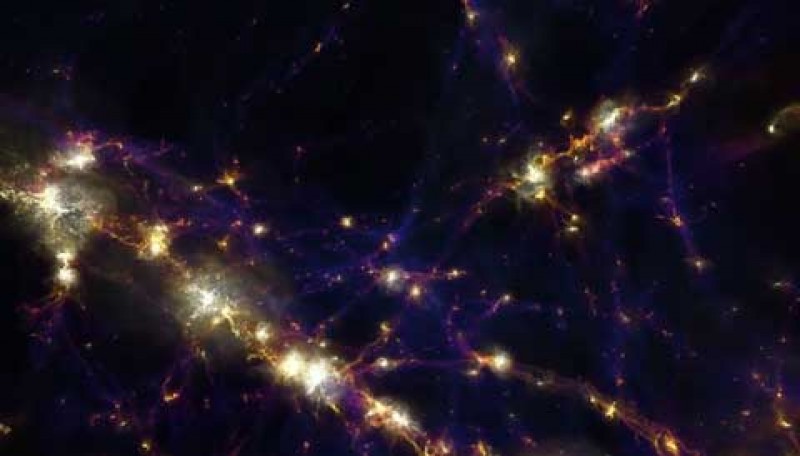
For almost 10 years, an international team of astrophysicists has been working on a project to simulate the evolution of the universe, from just after the Big Bang to the present day. Four years ago these simulations, known as Illustris, were the first to closely replicate the diversity of galaxies we observe in the real universe, producing “red and dead” ellipticals, star-forming spirals, and more exotic systems.
But a recent announcement brings a fresh level of sophistication to the table. The first three papers from Illustris: The Next Generation (IllustrisTNG) simulate a much bigger slice of universe at higher resolution than its predecessor.
Although still not on the grand, universe-wide scale of simulations that solely follow dark matter’s interaction with gravity, IllustrisTNG is large enough to provide a cosmological context to the processes it monitors. And despite not being as granular as “zoom-in” simulations that follow the small-scale evolutions within a single galaxy, IllustrisTNG captures the physical principles behind the evolution of gas, stars, and galaxies. As such, this new suite of simulations represents a big step toward bridging small-scale physics with large-scale evolution.
For one simulation run, IllustrisTNG used 24,000 processors over the course of more than two months on the fastest supercomputer in Germany: Hazel-Hen at the Supercomputing Center in Stuttgart. These simulations produced more than 500 terabytes of data — more than three times the information that the Hubble Space Telescope has collected over its entire lifetime.
These new data offer insights into fundamental astrophysical processes, including the growth and evolution of cosmic magnetic fields and galaxies, as well as the role black holes play in influencing the distribution of dark matter and killing off galactic star formation.

This visualization shows gas (blue) surrounding dark matter structures (orange/white).
IllustrisTNG
For example, Annalisa Pillepich (Max Planck Institute for Astronomy, Germany) and colleaguespredict what a faint stellar glow around large galaxies should look like. When smaller galaxies violently collide with each other, they lose stars, which relocate to a halo around the newly merged galaxy. IllustrisTNG’s results show that this halo can take all sorts of different shapes, depending on how the galaxy formed. Now, astronomers can match observations of a real-world stellar halo to simulation results, yielding the assembly history of that galaxy. Such comparisons could reveal how invisible dark matter halos build cosmic structure such as galaxy clusters and the filaments that connect them.
Key to this and other findings has been enriching the physics included in the simulations. For example, previous attempts at simulating the cosmos have omitted magnetic fields for simplicity. But Mark Vogelsberger (MIT) points out, “Magnetic fields can impact galaxy and star formation, so it is important to model them properly.”
Federico Marinacci (MIT), Vogelsberger, and colleagues study how large-scale magnetic fields in the IllustrisTNG universe form and grow over time. They have found that turbulence in hot, spread-out gases in the heart of galaxies drives small-scale dynamos that can exponentially amplify the magnetic fields. The strength of these amplified fields matches observations. With little known about where magnetic fields come from or what precise role they play in various cosmic processes, further results from IllustrisTNG are expected to illuminate these mysteries.
This movie visualizes the evolution of cosmic magnetic fields: blue/purple regions have low magnetic energy, typically along filaments of the cosmic web, while orange/white areas indicate regions of higher magnetic energy, typically inside halos and galaxies. This simulation is 30 million light-years wide.
IllustrisTNG collaboration
The astrophysicists have also improved the accuracy of IllustrisTNG by comparing their original Illustris simulations to observations. For example, they realized that the model of how supermassive black holes gobble up gas and spit it out was too violent, removing too much gas from the host galaxy. As a result, they rewrote the model based on feedback that doesn’t lead to massive gas losses. With this new model, Dylan Nelson (Max Planck Institute for Astronomy) and the Illustris teamfound compelling evidence that black hole jets can stop galaxies of a certain mass from giving birth to new stars.
In the simulation’s larger galaxies, “the black holes are able to supply enough energy to the surrounding gas to prevent it from cooling and fragmenting into stars,” explains IllustrisTNG’s principal investigator Volker Springel (Heidelberg University, Germany).
This video follows the formation of a massive, spiral galaxy, showing the light from its stars over a region roughly 1 million light-years wide. The galaxy forms stars rapidly until it mergers with a galactic companion of nearly equal mass (at approximately z ~ 0.3).
IllustrisTNG collaboration
Astronomers and astrophysicists will continue to learn from IllustrisTNG about the interconnected cosmic processes that have shaped our universe. Yet the team behind the simulations is not one to rest on its laurels: “There are still many things we would like to do better in future calculations,” observes Springel.
For example, although IllustrisTNG’s biggest simulations ran in a box nearly 1 billion light-years on a side, this volume is relatively small for cosmological simulations. The team will be keen to push the simulations to new limits. Springel and his collaborators are also already working on adding even more physics to the mix, including highly energetic particles known as cosmic rays, which may be important in regulating star formation, and novel methods to simulate the dust content in galaxies.
Source: Ben Skuse